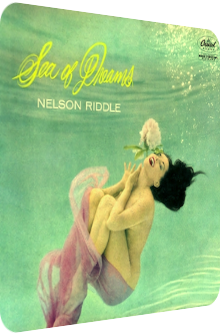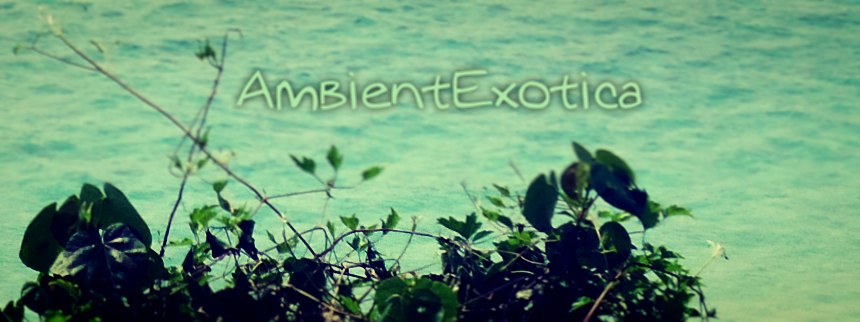
Nelson Riddle
Sea Of Dreams
1958
Sea Of Dreams by Nelson Riddle (1921–1985) was released in 1958 on Capitol Records, but not only did it have to fend off a glut of Exotica releases of all flavors, for Riddle himself was his biggest competitor in the realms of string-laden Easy Listening: His own album C'mon… Get Happy, released in the same year, is Riddle’s more successful album, peaking at #20 in the Billboard Charts. However, Sea Of Dreams is much more lush, romantic and, most important in the given context, exotic. If you are begging for sarcasm, one could say that Riddle copies Les Baxter’s sound perfectly, which would neither be an insult, nor a coincidence, for Riddle teamed up with Baxter quite a lot and was in fact hired by him in order to come up with releases on Capitol Records.
If you are craving for the romantic side of the Exotica genre, you are making the right choice with Sea Of Dreams. Instead of interweaving exotic percussion with the surroundings, Riddle concentrates exclusively on the strings, leaving a small niche for mallet instruments and bells of all kinds. In his later years, Riddle presented some variety in his albums, but here, the sphere of action is much more restricted, or as the saying goes, once you know one song, you know them all. The coherence isn’t bad at all, though, for romantic Exotica records need to maintain a certain quality in their continuity, I believe, so be aware of this. It’s also harder to write about them in greater detail. If you don’t like romantic Exotica and favor the tropical heat and bongo-driven savagery, you better stay away from it. I won’t, as the following paragraphs will show.
Out Of The Night starts majestically and features a mellifluousness that is definitely kitschy. The whirling strings merge perfectly with the sustained serenity of main melody. Careful harp tones add articulated warmth to the mix which shows that Riddle doesn’t inundate the listener with string washes, but actually leaves room enough for placidity and particularities of other instruments. A negligible intro, if you ask me. The following classic My Isle Of Golden Dreams, though, is a killer track, even though this is just some cruddy Easy Listening album, right? Well, it’s not cruddy at all due to the start of the track which features gorgeous harp sprinkles and a careful fade-in of the string orchestra that plays extremely lush and dreamy. Additional xylophones shimmer through from the background and the character of the main melody is the slightest bit drugged or warped – yes, seriously –, making the first half of the track a surprisingly modern peculiarity in the genre. The second half is smoochy Easy Listening by the numbers whose sky-high strings are enhanced with quieter, blurry counterparts. Taking the limiting genre boundaries into account, this track is all the more successful in depicting the longing for an island in the tropics.
Tango Tahiti (The Call Of Tahiti) is equally great, surprisingly laid back and reduced in volume. This has nothing to do with a Tango as we know it today, so don’t expect an explosive hot-blooded performance. The pulsating strings are meandering and spread spaces all over the song. Even though the volume is low, the strings are pompous and warm. Success! The next title is simply titled Dream and consists of violins played in high ranges but due to the sheer amount of violinists, the listener is washed away in terrifically mellow strings. The last song of side A, Drifting And Dreaming, has one particular element that you didn’t hear before on the album: Short double bass droplets create a lush bass line that works perfectly well with the acoustic guitar, the dark harp strings and the glinting xylophones. When the violinists return in full force, these diversified elements are still audible. In the boundaries of Sea Of Dreams, these small additions could be called risks or even dynamic experiments … but again, begone, sarcasm!
Easter Isle is a top-notch start of side B and continues the variety shown in Drifting And Dreaming. A repetitive two-note harp melody is soaked up and echoed by glitzy xylophones. The strings work particularly well and the cascading harp is utterly gorgeous. The double bass backings are again a vibrant rhythmic device. This could well be the Riddle’s best song that is featured on Sea Of Dreams. I’m not too sure about this due its the steady variety, but my rule of thumb is basically the following: once an string-laden Easy Listening track features a variety of additional instruments, it is certainly good.
Let’s Fall In Love is the next great tune, and due to its name, the strings are even more lush than they were before, encapsulating a romance that erupts in multilayered melodies, for example darkly trilling strings, blissful harp chords and bold string washes. Jimmy Van Heusen’s 1940 Jazz standard Polka Dots And Moonbeams is next, and the transition can only be called phantasmagoric. The main melody is still recognizable, but much more dreamlike due to the full-scale orchestra. While the French classic Autumn Leaves is the most melancholic song on the album with the greatest wanderlust mood and a melodramatic motif that is interchanged with short outbursts of happiness, the final title-giving track Sea Of Dreams is a typical closer that is exuberant in its depiction of care-free happiness and majestic serenity. The final harp tones in the last 15 seconds show the great weakness of the whole album: the concentration on violins rather and the inferiority of other string instruments.
Nelson Riddle delivers just another Easy Listening album in the pool of many other releases. In 1958 alone, he released at least 11 LP’s! Consistent quality is the tractive force we all strive for, but if a certain quality level is reached, the result is a whitewashed plateau. Sea Of Dreams has its moments and gorgeous tunes – My Isle Of Golden Dreams, Easter Isle and, ahem, Let’s Fall In Love come to mind –, but its coherence and raison d’être prevent it from making a long-lasting impression in its entirety. In contrast to Les Baxter’s way of conducting, the strings aren’t remarkable and effervescent enough. The mood doesn’t change at all, there are no dark undertones, and only Autumn Leaves allows a strong wave of melancholy to enter the Sea Of Dreams. The Exotica level is still appropriate enough for me to consider this album in this section due to its island theme and the topics of reveries and romance.
The only outstanding inclusions are a few mallet instruments and harp strings that could have enhanced the Exotica factor if they had been used more often. Recommended for the aforementioned target audience and fans of Les Baxter. Not recommended, though, for listeners who want energetic, tropical and percussion-driven Exotica skits; this niche is better served with the official next of kin to Sea Of Dreams, the much more exotic Love Tide, released on Capitol Records in 1961. That album even features two original tunes written by Nelson Riddle, and although I do not see that great a connection between Love Tide and Sea Of Dreams, it is a noteworthy contender as well. In smaller doses and in the right moments, Riddle’s Sea Of Dreams is charming. It is also easily available on digital music stores and streaming services.
Ambient Review 070: Nelson Riddle – Sea Of Dreams (1958). Originally published on May 19, 2012 at AmbientExotica.com.
